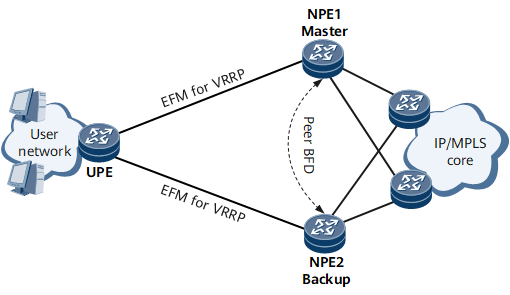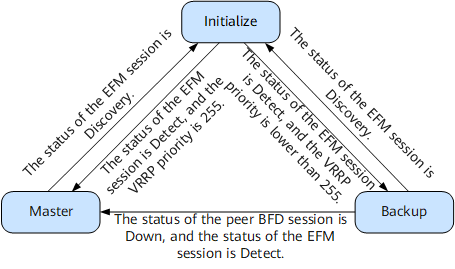VRRP Tracking EFM
Principles
Metro Ethernet solutions use Virtual Router Redundancy Protocol (VRRP) tracking Bidirectional Forwarding Detection (BFD) to detect link faults and protect links between the master and backup network provider edges (NPEs) and between NPEs and user-end provider edges (UPEs). If UPEs do not support BFD, Metro Ethernet solutions cannot use VRRP tracking BFD. If UPEs support 802.3ah, Metro Ethernet solutions can use 802.3ah as a substitute for BFD to detect link faults and protect links between NPEs and UPEs. Ethernet operation, administration and maintenance (OAM) technologies, such as Ethernet in the First Mile (EFM) OAM defined in IEEE 802.3ah, provide functions, such as link connectivity detection, link failure monitoring, remote failure notification, and remote loopback for links between directly connected devices.
Implementation

EFM can detect only local link failures. If the link between the UPE and NPE1 fails, NPE2 cannot detect the failure. NPE2 has to wait three VRRP Advertisement packet transmission intervals before it switches to the Master state. During this period, upstream service traffic is interrupted. To speed up master/backup VRRP switchovers and minimize the service interruption time, configure VRRP also to track the peer BFD session.
Figure 1 shows a network on which VRRP tracking EFM is configured. NPE1 and NPE2 are configured to belong to a VRRP group. A peer BFD session is configured to detect the faults on the two NPEs and on the link between the two NPEs. An EFM session is configured between the UPE and NPE1 and between the UPE and NPE2 to detect the faults on the UPE and NPEs and on the links between the UPE and NPEs. The VRRP group determines the VRRP status of NPEs based on the link status reported by EFM and the peer BFD session.
In Figure 1, the following example describes how EFM and a peer BFD session affect the VRRP status when a fault occurs and rectified.
- NPE1 and NPE2 run VRRP.
- A peer BFD session is established between NPEs to detect link and device failures on the link between the NPEs.
- An EFM session is established between NPE1 and the UPE and between NPE2 and UPE to detects link and node faults on the links between NPEs and the UPE.
- In normal circumstances, NPE1 periodically sends VRRP Advertisement packets to inform NPE2 that NPE1 works properly. NPE1 and NPE2 both track the EFM and peer BFD session status.
- If NPE1 or the link between the UPE and NPE1 fails, the status of the EFM session between the UPE and NPE1 changes to Discovery, the status of the peer BFD session changes to Down, and the status of the EFM session between the UPE and NPE2 changes to Detect. NPE1's VRRP status directly changes from Master to Initialize, and NPE2's VRRP status directly changes from Backup to Master.
- After NPE1 or the link between the UPE and NPE1 recovers, the status of the peer BFD session changes to Up, and the status of the EFM session between the UPE and NPE1 changes to Detect. If the preemption function is configured on NPE1, NPE1 changes back to the Master state after VRRP negotiation, and NPE2 changes back to the Backup state.

In normal circumstances, if the link between the UPE and NPE2 fails, NPE1 remains in the Master state and continues to forward upstream traffic. However, NPE2's VRRP status changes to Master if NPE2 detects the Down state of the peer BFD session before it detects the Discovery state of the link between itself and the UPE. After NPE2 detects the Discovery state of the link between itself and the UPE, NPE2's VRRP status changes from Master to Initialize.
Benefits
VRRP tracking EFM facilitates master/backup VRRP switchovers on a network on which UPEs do not support BFD but support 802.3ah.

